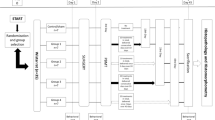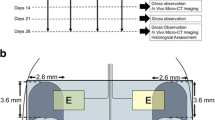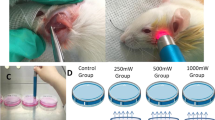Abstract
The aim of the present study was to investigate the therapeutic effects of 660-nm and 880-nm photobiomodulation therapy (PBMT) following inferior alveolar nerve (IAN) crush injury. Following the nerve crush injuries of IAN, 36 Wistar rats were randomly divided into three groups as follows: (1) control, (2) 660-nm PBMT, and (3) 808-nm PBMT (GaAlAs laser, 100 J/cm2, 70 mW, 0.028-cm2 beam). PBMT was started immediately after surgery and performed once every 3 days during the postoperative period. At the end of the 30-day treatment period, histopathological and histomorphometric evaluations of tissue sections were made under a light and electron microscope. The ratio of the inner axonal diameter to the total outer axonal diameter (g-ratio) and the number of axons per square micrometer were evaluated. In the 808-nm PBMT group, the number of nerve fibers with suboptimal g-ratio ranges of 0–0.49 (p < 0.001) is significantly lower than expected, which indicates better rate of myelinization in the 808-nm PBMT group. The number of axons per square micrometer was significantly higher in the 808-nm PBMT group when compared with the control (p < 0.001) and 660-nm PBMT group (p = 0.010). The data and the histopathological investigations suggest that the PBMT with the 808-nm wavelength along with its settings was able to enhance IAN regeneration after nerve crush injury.



Similar content being viewed by others
References
Bataineh AB (2001) Sensory nerve impairment following mandibular third molar surgery. J Oral Maxillofac Surg 59:1012–1017
Ellies LG, Hawker PB (1993) The prevalence of altered sensation associated with implant surgery. Int J Oral Maxillofac Implants 8:674–679
Grötz KA, Al-Nawas B, de Aguiar EG et al (1998) Treatment of injuries to the inferior alveolar nerve after endodontic procedures. Clin Oral Investig 2:73–76
Haas DA (2006) Articaine and paresthesia: epidemiological studies. J Am Coll Dent 73:5–10
McLeod NMH, Bowe DC (2016) Nerve injury associated with orthognathic surgery. Part 2: inferior alveolar nerve. Br J Oral Maxillofac Surg 54:366–371
Tay ABG, Bin LJ, Lye KW et al (2015) Inferior alveolar nerve injury in trauma-induced mandible fractures. J Oral Maxillofac Surg 73:1328–1340
Sumer M, Bas B, Yıldız L (2007) Inferior alveolar nerve paresthesia caused by a dentigerous cyst associated with three teeth. Med Oral Patol Oral Cir Bucal 12:E388–E390
Schultze-Mosgau S, Reich RH (1993) Assessment of inferior alveolar and lingual nerve disturbances after dentoalveolar surgery, and of recovery of sensitivity. Int J Oral Maxillofac Surg 22:214–217
Long H, Zhou Y, Liao L et al (2012) Coronectomy vs. total removal for third molar extraction: a systematic review. J Dent Res 91:659–665
Leung YY, Fung PP-L, Cheung LK (2012) Treatment modalities of neurosensory deficit after lower third molar surgery: a systematic review. J Oral Maxillofac Surg 70:768–778
Alhassani AA, AlGhamdi AST (2010) Inferior alveolar nerve injury in implant dentistry: diagnosis, causes, prevention, and management. J Oral Implantol 36:401–407
Angeletti P, Pereira MD, Gomes HC et al (2010) Effect of low-level laser therapy (GaAlAs) on bone regeneration in midpalatal anterior suture after surgically assisted rapid maxillary expansion. Oral Surg Oral Med Oral Pathol Oral Radiol Endod 109:e38–e46
Wang X, Tian F, Reddy DD et al (2017) Up-regulation of cerebral cytochrome-c-oxidase and hemodynamics by transcranial infrared laser stimulation: a broadband near-infrared spectroscopy study. J Cereb Blood Flow Metab 37:3789–3802
Rojas JC, Gonzalez-Lima F (2013) Neurological and psychological applications of transcranial lasers and LEDs. Biochem Pharmacol 86:447–457
de Rosso MPO, Buchaim DV, Kawano N et al (2018) Photobiomodulation therapy (PBMT) in peripheral nerve regeneration: a systematic review. Bioengineering 5:44–56
Hashmi JT, Huang Y-Y, Osmani BZ et al (2010) Role of low-level laser therapy in neurorehabilitation. PM R 2:S292–S305
Coulthard P, Kushnerev E, Jm Y et al (2014) Interventions for iatrogenic inferior alveolar and lingual nerve injury. Cochrane Database Syst Rev 16:CD005293
Naftel JP, Richards LP, Pan M, Bernanke JM (1999) Course and composition of the nerves that supply the mandibular teeth of the rat. Anat Rec 256:433–447
Germanà G, Muglia U, Santoro M et al (1992) Morphometric analysis of sciatic nerve and its main branches in the rabbit. Biol Struct Morphog 4:11–15
Peng Q, Juzeniene A, Chen J et al (2008) Lasers in medicine. Rep Prog Phys 71:1–28
Rochkind S, Leider-Trejo L, Nissan M et al (2007) Efficacy of 780-nm laser phototherapy on peripheral nerve regeneration after neurotube reconstruction procedure (double-blind randomized study). Photomed Laser Surg 25:137–143
Andreo L, Soldera CB, Ribeiro BG et al (2017) Effects of photobiomodulation on experimental models of peripheral nerve injury. Lasers Med Sci 32:2155–2165
Gasperini G, De Siqueira ICR, Costa LR (2014) Lower-level laser therapy improves neurosensory disorders resulting from bilateral mandibular sagittal split osteotomy: a randomized crossover clinical trial. J Cranio-Maxillofacial Surg 42:e130–e133
Guarini D, Gracia B, Ramírez-Lobos V et al (2018) Laser biophotomodulation in patients with neurosensory disturbance of the inferior alveolar nerve after sagittal split ramus osteotomy: a 2-year follow-up study. Photomed Laser Surg 36:3–9
Alghamdi KM, Kumar A (2012) Low-level laser therapy : a useful technique for enhancing the proliferation of various cultured cells. Lasers Med Sci 27:237–249
Barez MM, Tajziehchi M, Heidari MH et al (2017) Stimulation effect of low level laser therapy on sciatic nerve regeneration in rat. J Lasers Med Sci 8:S32–S37
Wang CZ, Chen YJ, Wang YH et al (2014) Low-level laser irradiation improves functional recovery and nerve regeneration in sciatic nerve crush rat injury model. PLoS One 9:e103348
Takhtfooladi MA, Jahanbakhsh F, Takhtfooladi HA et al (2015) Effect of low-level laser therapy (685 nm, 3 J/cm2) on functional recovery of the sciatic nerve in rats following crushing lesion. Lasers Med Sci 30:1047–1052
Takhtfooladi MA, Sharifi D (2015) A comparative study of red and blue light-emitting diodes and low-level laser in regeneration of the transected sciatic nerve after an end to end neurorrhaphy in rabbits. Lasers Med Sci 30:2319–2324
Medalha CC, Di Gangi GC, Barbosa CB et al (2012) Low-level laser therapy improves repair following complete resection of the sciatic nerve in rats. Lasers Med Sci 27:629–635
Barbosa RI, Marcolino AM, De Jesus Guirro RR et al (2010) Comparative effects of wavelengths of low-power laser in regeneration of sciatic nerve in rats following crushing lesion. Lasers Med Sci 25:423–430
de Martins DO, dos Santos FM, de Oliveira ME et al (2013) Laser therapy and pain-related behavior after injury of the inferior alveolar nerve: possible involvement of neurotrophins. J Neurotrauma 30:480–486
de Martins DO, dos Santos FM, Ciena AP et al (2017) Neuropeptide expression and morphometric differences in crushed alveolar inferior nerve of rats: effects of photobiomodulation. Lasers Med Sci 32:833–840
Souza-Barros L, Dhaidan G, Maunula M et al (2018) Skin color and tissue thickness effects on transmittance, reflectance, and skin temperature when using 635 and 808 nm lasers in low intensity therapeutics. Lasers Surg Med 50:291–301
Nasouri B, Murphy TE, Berberoglu H (2014) Simulation of laser propagation through a three-layer human skin model in the spectral range from 1000 to 1900 nm. J Biomed Opt 19:075003
Miloro M, Criddle TR (2018) Does low-level laser therapy affect recovery of lingual and inferior alveolar nerve injuries? J Oral Maxillofac Surg 76:2669–2675
Miloro M, Halkias LE, Mallery S et al (2002) Low-level laser effect on neural regeneration in Gore-Tex tubes. Oral Surg Oral Med Oral Pathol Oral Radiol Endod 93:27–34
Angius D, Wang H, Spinner RJ et al (2012) A systematic review of animal models used to study nerve regeneration in tissue-engineered scaffolds. Biomaterials 33:8034–8039
Wang X, Reddy DD, Nalawade SS et al (2017) Impact of heat on metabolic and hemodynamic changes in transcranial infrared laser stimulation measured by broadband near-infrared spectroscopy. Neurophotonics 5(1):011004
Funding
This research was funded by Baskent University Research Fund (Grand Number D-DA 14/06).
Author information
Authors and Affiliations
Corresponding author
Ethics declarations
Conflict of interest
The authors declare that they have no conflict of interest.
Ethical approval
All procedures performed in the present study, involving animals, were approved by the Institutional Review Board and Ethical Committee of Baskent University for experimental research on animals.
Additional information
Publisher’s note
Springer Nature remains neutral with regard to jurisdictional claims in published maps and institutional affiliations.
Rights and permissions
About this article
Cite this article
Diker, N., Aytac, D., Helvacioglu, F. et al. Comparative effects of photobiomodulation therapy at wavelengths of 660 and 808 nm on regeneration of inferior alveolar nerve in rats following crush injury. Lasers Med Sci 35, 413–420 (2020). https://doi.org/10.1007/s10103-019-02838-w
Received:
Accepted:
Published:
Issue Date:
DOI: https://doi.org/10.1007/s10103-019-02838-w




